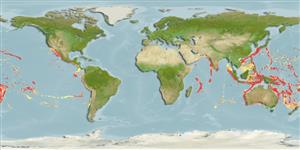Common names from other countries
Environment: milieu / climate zone / depth range / distribution range
экология
донно-пелагический; пределы глубины 200 - 1475 m (Ref. 96667). Deep-water; 33°N - 40°S, 54°E - 71°W
Indo-Pacific.
Length at first maturity / Size / Вес / Возраст
Maturity: Lm ? range ? - ? cm
Typically found near the sea floor in deep-seas. Its characteristic 3 pairs of extremely long, stilt-like pereiopods suggest its ability to walk on soft sediments. An opportunistic feeder, relying on phototrophically derived organic matter. Its feeding strategy may be assumed to be similar with its congener, N. exilis, a scavenger and predator that feeds mainly on fish remains and slow-moving benthic organisms. Shown to produce oval eggs (0.5 to 0.65 mm length) and may possibly achieve several reproductive outputs in its relatively long lifespan of 2 to 3 years (Ref. 97382).
Life cycle and mating behavior
половая зрелость | размножение | нерест | икра | Fecundity | личинки
Members of the order Decapoda are mostly gonochoric. Mating behavior: Precopulatory courtship ritual is common (through olfactory and tactile cues); usually indirect sperm transfer.
Основная ссылка
ссылки | координатор | соавторы
Poupin, J. 1998. (Ref. 75706)
Статус Красного Списка МСОП (Ref. 130435)
Статус СИТЕС (Ref. 108899)
Not Evaluated
Not Evaluated
Использование человеком
| FishSource |
инструменты
дополнительная информация
Возраст/Размеры
рост
Зависимость между длиной и массой тела
Зависимость между длинами
морфология
личинки
численность
ресурсы в Интернет
Estimates based on models
Preferred temperature
(Ref.
115969): 6 - 12.8, mean 8.3 (based on 423 cells).
Категория цены
Unknown.
